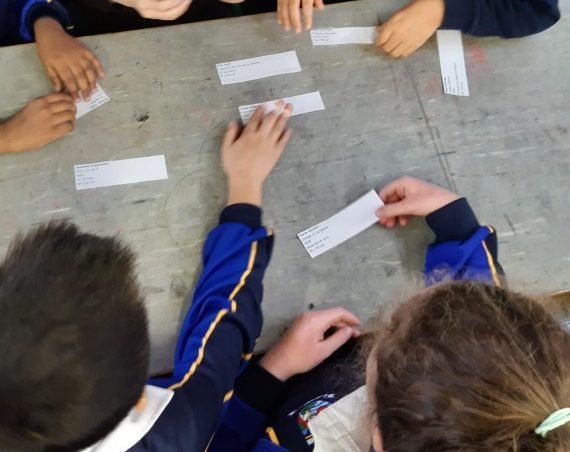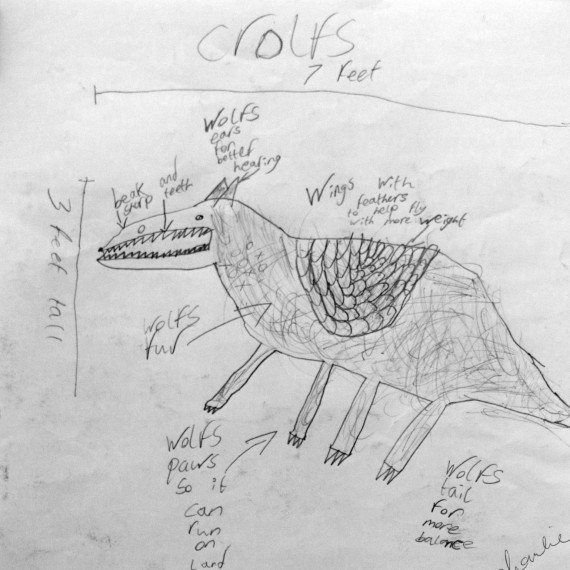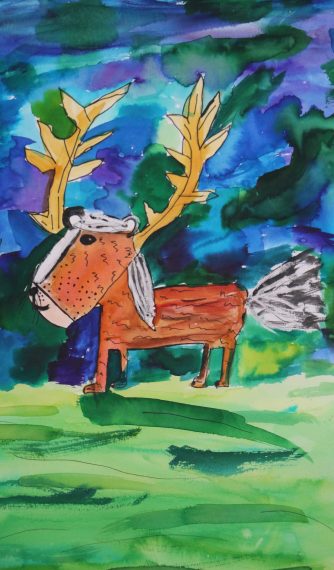Refine by Region
Refine by Art Form
Refine by School Level
ABC of the Three Muses – Virtual Museum

ABC of the Three Muses Mozilla Hubs Exhibition
Watch back the discussion with Public Engagement Coordinator Adam Stoneman, The Hunt Museum’s Education Coordinator, Hannah Bloom and Artist Jo-Anne Hine as part of the 2021 Portal Regional Events.
Tell us the story of your project – What was the impetus? What was it about? Who was involved? How did you begin?
Jo-Anne Hine, Artist
How do you overcome the challenges of lockdown to bring creative experiences to school children and make them feel connected to museums and galleries?
In late 2020, despite the difficulties of life in lockdown, the children of three Limerick schools and their teachers critically and creatively engaged with museum collections, producing artworks for their own virtual museums. This innovative project was a new way for schools to collaborate with and access museum collections. It allowed children to engage with the three significant Limerick collections at a time when cultural heritage and arts institutions were closed and schools were limiting visits from outsiders to protect their communities.
As a starting point for ABC of the Three Muses, I took the definition of ABC as ‘the basic or most important facts about a subject’. This was in early Autumn when we were still enjoying a short reprieve from the virus. Then came restrictions and lockdown. With a redefined approach and a leap of faith I created workshops for teachers to deliver in their classrooms.
ABC of the Three Muses engaged children with three distinct museum collections in three different ways, providing learning experiences that were as authentic as possible in the circumstances. Led by their class teachers in their own classrooms, children responded creatively to printed reproductions of art works from the Limerick City Gallery of Art, digital 3D models of objects in The Hunt Museum, and a box of real objects on loan from Limerick Museum, which children could observe, touch and draw.
In some respects, the children’s experiences were richer than they may have been under normal circumstances. The extended time frame of the project, over a term, contributed to significant investment by each class, creating a rich environment for deep learning and cognition. As a result, and despite the museum and gallery closures, the children’s sense of access and ownership of Limerick’s cultural heritage (their own cultural heritage) has increased. This was achieved through a thoughtfully structured set of workshop-style lessons inviting children and their teachers to interrogate the facts about cultural and historical objects and ownership, culminating in the creation of a museum of hybrid creatures that might exist in a future Limerick.
While visual art and critical and creative thinking were foregrounded, the workshop style lessons and resources also provided rich links to other curriculum areas, such as English and History, which teachers could build on in their lessons. For instance, the box of objects on loan from Limerick Museum contained a Hurley that was used in 1973 by a famous Limerick player in the All-Ireland Hurling championship. One teacher used the Hurley to instigate class research to compare different aspects of the Limerick teams of 1973, 2018 and 2020.
An unexpected but valuable legacy of the project has been the professional development of the teachers. Their active participation in leading the children through the activities increased their skills, knowledge and confidence with art materials, while also raising their awareness of alternative approaches to their current art teaching practices. The teachers were fully supported through access to resources including all art materials, lesson plans, videos showing how to use charcoal and watercolours, worksheets, and PowerPoint presentations.
Iain Burns, Teacher Scoil Ide
Scoil Ide visits the Hunt Museum regularly for exhibitions. My 4th class completed the Three Muses Workshop in the last academic year and this year’s class did the ABC of the Three Muses. The impetus was to engage with art and artists in our local area. It involved the class, me the teacher, the school, the museums and their Education Team.
Fionnuala Bromell, Teacher Corpus Christi PS
Before COVID-19 restrictions, our school was excited to visit the three museums of Limerick. We thought it would be impossible this year. However, we were delighted to be informed that the project would go ahead virtually. We are a DEIS band 1 school and visiting Museums would not be the norm for our children therefore we are grateful for our children to access the art and artefacts of their city’s Museums and hopefully stir curiosity in them to pursue and enjoy the arts.
How were the ideas developed and how did the young people, artist and teacher work together?
Jo-Anne Hine, Artist
The preparatory phase occurred in September and October 2020 as Ireland embarked on Level 3 COVID-19 restrictions and schools were nervously recommencing after the extended closure over spring and summer. With the safety of school communities a priority, workshops in the schools were unable to proceed and art galleries and museums were closed. The project developed from an artist run workshop into a series of teacher led workshops. To facilitate this, I researched and wrote a unique unit of work with a cohesive series of 6 lesson plans that guided the class teachers, and their pupils, to explore the museum collections through critical and creative thinking strategies with a range of art making outcomes. I made digital resources to support the teaching and learning experiences which teachers accessed via Google drive. Art materials were delivered to each school. Through this reinvention of the project, the classroom teachers took ownership of it and were enabled by it. They were encouraged to adapt, adjust or refine the suggested activities to best meet the needs of their pupils, their own interests and time frames. In response to a need for consideration of the emotional wellbeing of pupils in such uncertain times, the lessons included opportunities for pupils to express their emotions, especially through a charcoal drawing exercise in response to a student choice of art work from Limerick City Gallery of Art.
I interacted with the teachers via their preferred method of communication, including, phone, zoom, email and text message. This worked for the teachers at a time when they were extremely busy and stressed because of COVID-19 compliance and uncertainty. For some teachers this experience created an opportunity for professional development in approaches to teaching visual art.
Iain Burns, Teacher Scoil Ide
The ideas were developed through conversations with the Education team at the museum regarding what schools need and how it can be delivered in the current climate. The museum then wrote up a series of lessons and the class engaged with them with the guidance of the class teacher and support of the Education team at the museum. Lessons were emailed to me and support materials and resources were delivered to the school. The children’s work was collected when the lessons were completed and a reflection sheet was sent from the children to the Museum’s Education Team. The Education Team was always available to me for guidance.
Fionnuala Bromell, Teacher Corpus Christi PS
There was a series of communications with Adam at the Hunt Museum and then the artist Jo-Anne explaining the process. I was the coordinator for my school so I spoke with Jo-Anne on many occasions on the phone, discussing the project and the resources. Jo-Anne dropped incredible resources to our school for every child. Detailed lesson plans were sent to us to allow us to match the classes to resources and prepare the children. All the classes had an online link to Google Drive where the children could see Jo-Anne and follow her instructions and hear her ideas.
What was your personal experience of the project in terms of successes and challenges?
Jo-Anne Hine, Artist
Initially I was disappointed that the physical workshops with the classes could not go ahead as anticipated. Because I couldn’t physically meet with the teachers and pupils to gauge and discuss their needs and abilities, I felt like I was flying blind. Once I began researching the collections and developing lesson plans and resources, I became really excited about the potential of the project. It was difficult for me to suggest only one or two activities per lesson because of the richness of the collections and possible links to curriculum and interests. In the end this turned out to be a positive that allowed for the teachers and students to pick and choose their approaches to the inquiry question or theme of each lesson. Each lesson included extension activities to cater for a broad range of interests and abilities. I was mindful that this could also cause the teachers to be overwhelmed by the suggested content, so in my weekly communication with them I reiterated the flexibility of approach that was embedded in the lesson plans.
Iain Burns, Teacher Scoil Ide
I found it an excellent initiative. The lessons were of a high standard with clear learning intentions, extensive resources and supports. They were curriculum relevant and appropriately pitched, with room for differentiation. It’s always good to collaborate with external agencies that have a clear vision and understanding of children’s education. This can give richness to the delivery of the curriculum that a teacher may not be able to achieve on their own as the breadth of the curriculum is vast. COVID-19 provided challenges. It would be great if the artists could visit the classroom and deliver a lesson in the series. That was not possible with COVID-19 restrictions.
Kate (4th Class) says, “the best part of the project was hearing the stories about the old things that we held.”
Fionnuala Bromell, Teacher Corpus Christi PS
The programme was a great experience for our children and for our teachers. The variety of media, styles and skills were excellent. As teachers it showed us how to develop art classes and not skip straight to the product. We will definitely spend more time on the process going forward. The only challenge was time. The children could have spent more time on each class. We will continue with that now.
The feedback from children in this group was positive. They wanted more time and to extend the project by making the creature in clay. Charlie (5th Class) wrote “I personally think the best part of the project was the hybrid animals but everything was lovely. Oh, and I love the bit on the last day seeing legend Joe McKena’s Hurley, especially after the final win.”
What was significant for you about the project that is worth sharing?
Jo-Anne Hine, Artist
This project provides a different way of approaching visual art in the primary classroom. The unit of work is significant because it is a cohesive series of lessons that provide a context for art making and responding, with the museum collections as the stimulus. Each lesson plan has suggested activities that connect to a range of different subject/knowledge areas and is therefore an example of how art can be a vehicle for learning in English, History, Maths, Geography, Science and Languages. Thus, creating an overlap for rich and meaningful cross curricular learning. The means of displaying the work as a virtual museum using Mozilla Hubs was a very effective, innovative and engaging outcome where whole school communities could interact with and navigate through the virtual spaces to see the pupil’s works. Adam Stoneman from The Hunt Museum built the virtual museum spaces for us.
Iain Burns, Teacher Scoil Ide
It was engaging, varied, designed to a high standard and was curriculum relevant.
All primary schools would benefit from engaging with the programme.
Fionnuala Bromell, Teacher Corpus Christi PS
Taking the mystery out of art and visiting Museums is very important for our children. Museums would not be a part of these children’s normal experiences so showing them how accessible it can be and how these Museums are at their finger-tips is excellent.
Has anything changed in your work as a result of the project?
Jo-Anne Hine, Artist
Working remotely provided opportunities to engage with technology. As I was not in the classroom to discuss ideas and demonstrate techniques, I learned to use screen-casting to engage students and teachers with the project. I can see a place for retaining and developing these skills in future projects even after restrictions are ceased.
Iain Burns, Teacher Scoil Ide
It provided a different perspective of the art curriculum in particular. I would now be more confident in using various resources and would have no hesitancy in engaging with the museum as a collaborator.
Fionnuala Bromell, Teacher Corpus Christi PS
Yes. We will look differently at how we present art classes and avoid mass produced pieces and encourage individuality. We will also spend more time developing visual art classes and sourcing resources to support them.
Full list of Schools & Teachers Involved:
- Scoil Ide, Corbally Road, Limerick – Iain Burns
- Corpus Christi Primary School Moyross Limerick – Fionnuala Bromell, Diarmuid Hickey, Dympna Gannon, Orfhlaith Prendergast.
- St Anne’s Primary School, Rathkeale – Kenneth Brown
Spotlight
Artist(s):
Jo-Anne Hine, Artist
I am a Visual Artist and educator and have recently moved to Ireland to live. I firmly believe that knowledge doesn’t belong in siloes and that all curriculum areas can be taught through the Arts, especially in primary school. An example of my collaborative practice while working at Cannon Hill Anglican College, is the development and implementation of a STEAM subject for Year 9 students, in which I collaborated with a science teacher colleague.
I have a Masters of Visual Art and am a certified Lead Teacher. I’ve worked with Primary students, Secondary students and adults. I’ve recently worked with the Queensland Curriculum and Assessment Authority as the Principal Education Officer for Visual Art in a role that involved training Visual Art teachers in a new syllabus for Senior Secondary students. I have co-authored a Visual Art text book for senior students. I was recently the President of the Queensland Art Teachers Association and have created learning resources for The Museum of Brisbane, The State Library of Queensland and the Queensland Art Gallery.
Teacher(s):
Full list of Schools & Teachers Involved:
- Scoil Ide, Corbally Road, Limerick - Iain Burns
- Corpus Christi Primary School Moyross Limerick - Fionnuala Bromell, Diarmuid Hickey, Dympna Gannon, Orfhlaith Prendergast.
- St Anne’s Primary School, Rathkeale - Kenneth Brown
Iain Burns, Teacher Scoil Ide
I have been teaching for nearly 20 years. I have taught in Europe, Asia and Ireland. I was seconded to the NCCA in Ireland to work on the redevelopment of the primary school curriculum and the new maths curriculum.
I have extensive experience in engaging in collaborative practice, particularly with Mary Immaculate College where I worked with a lecturer and published work regarding a continued module on Geoliteracy.
Fionnuala Bromell, Teacher Corpus Christi PS
I am a post holder for Creative Arts in Corpus Christi P.S. We are part of Creative schools sponsored by Arts Ireland. Last year we were one of the schools involved with Better Words Art programme for E.V.A. Our children worked with artists in residence in the school and visited IMMA and the project culminated in a publication where children were presented with their own books.
I am heavily involved in the expressive arts in Corpus Christi, producing large musicals every second year that are staged in L.I.T .We are Borg Gáis Energy award winners in drama.
We also write and produce original films and we are three times Fresh Film award winners.
Other:
(Curator, agency, etc):
The Three Muses programme is a joint education initiative between The Hunt Museum, Limerick City Gallery of Art and Limerick Museum, launched in November 2019. It works to increase access, ownership and enjoyment of three Limerick museum collections with a focus on modern and contemporary visual art. The programme includes workshops, events and digital resources. It is funded by Limerick City and County Council and The Hunt Museum.

Artist(s)
Jo-Anne Hine

Teacher(s)
Fionnuala Bromell
Iain Burns
Diarmuid Hickey
Orfhlaith Prendergast
Dympna Gannon
Artforms
School Level
School/
Participant Group
Corpus Christi Primary School, Moyross, Limerick, Scoil Ide, Corbally Road, Limerick, St Anne’s Primary School, Rathkeale, Limerick
No. Participants
92
Region
Age/Class
8 - 11 Years
Dates
The resources were in the schools ready to begin in the first week in November, 2020. Virtual exhibition launched mid-December 2020.
Weblinks
Link to the Main Gallery, which introduces the project: hubs.mozilla.com/ExYxDtG/abc-of-the-three-muses-virtual-exhibition/
Link to The Hunt Museum Blog outline of the project
huntmuseum.com/2020/12/15/childrens-imaginations-still-soar-despite-restrictions/
Leading Agency
The Hunt Museum
Other Partners and/or Funders
Limerick City Gallery of Art, Limerick Museum
Key themes/ lines of enquiry
Exploring museum collections as a stimulus for art making, including creating a hybrid creature to feature in a class museum; investigating the connection between objects and their museum labels through critical and creative thinking; close observation resulting in drawings and writing of and about collection objects; exploring collections using digital access and physical engagement with real objects.
Curriculum Strands
Art, History, Languages, Geography, Mathematics, English, oral and written languages.
Research or relevant publications
Brown, A, Hine, J, Peachey, A, Seidel, J, Shead, L, Towers, D 2019, Creative Inquiry, Cambridge University Press, Melbourne.
Limerick City Gallery of Art 1999, Kingdom of Heaven, Gandon Editions, Cork.
The Hunt Museum 2002, The Hunt Museum: Essential Guide, Scala Publishers, London.
Uribe, K 2018, ABC the Alphabet of Bilbao Museum exhibition catalogue, Bilboko Arte Ederren Museoa, Bilbao.
An unexpected but valuable legacy of the project has been the professional development of the teachers. Their active participation in leading the children through the activities increased their skills, knowledge and confidence with art materials, while also raising their awareness of alternative approaches to their current art teaching practices.
Jo-Anne Hine







